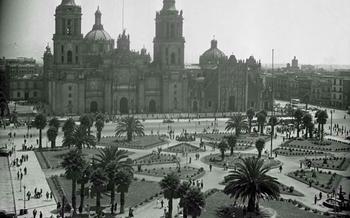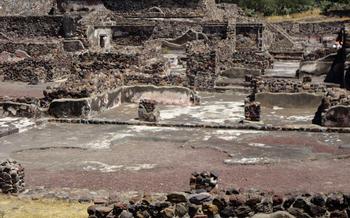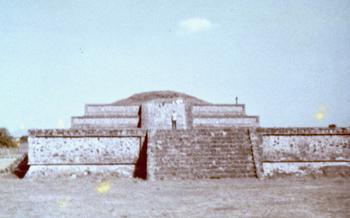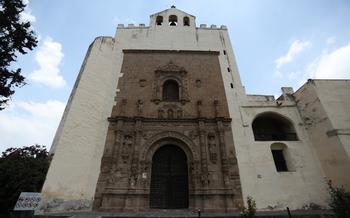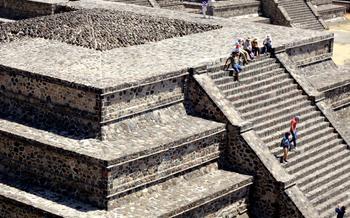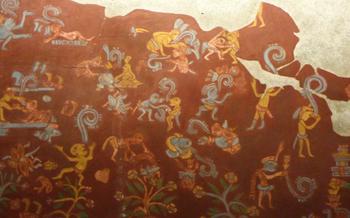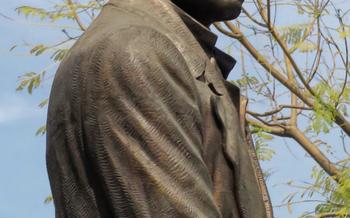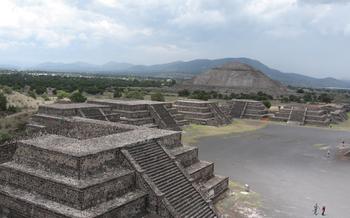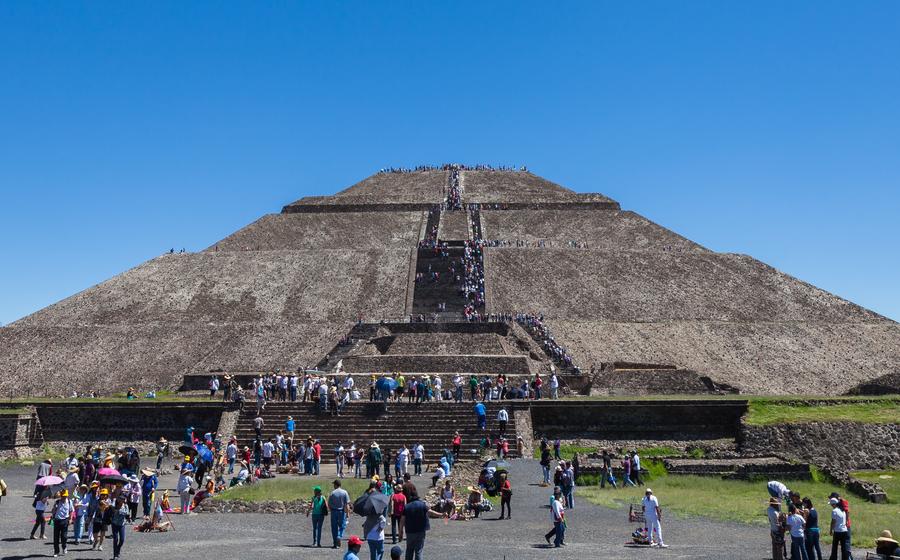
Parque Nacional Cerro de la Estrella
- Background and Significance
- Navigating the Park
- Iconic Landmarks
- Exploring the Flora and Fauna
- Cultural and Religious Significance:
- Family-Friendly Activities
- Photography and Nature Appreciation:
- Unique Experiences
- Local Cuisine and Restaurants:
- Safety and Precautions:
- Park Fees and Reservations
- Shopping and Souvenirs
- Best Time to Visit
- Getting There and Transportation
- Insider Tips for an Unforgettable Experience:
Background and Significance
Ancient Legends and Myths:
The Parque Nacional Cerro de la Estrella holds a special place in Mexican mythology and folklore. Ancient legends speak of the park being the birthplace of the gods, where the creator god Huitzilopochtli emerged from the womb of Coatlicue, the earth goddess. The park's iconic landmarks, such as the Labyrinth and the Cave of the Goat, are believed to be portals to the underworld and places of spiritual significance.
Archaeological Findings and Discoveries:
Archaeological excavations within the park have uncovered ancient ruins and artifacts that shed light on the region's rich pre-Hispanic past. The most notable discovery was the Pyramid of Cuicuilco, one of the oldest pyramids in Mesoamerica, dating back to the 8th century BC. Other significant findings include petroglyphs, ceramics, and obsidian tools, providing valuable insights into the lives and rituals of the ancient inhabitants.
Conservation Efforts and the Park's Current Status:
In recognition of its cultural and ecological importance, the Parque Nacional Cerro de la Estrella was designated as a national park in 198Conservation efforts are underway to protect the park's unique ecosystem and preserve its historical and cultural heritage. The park's current status as a protected area ensures that future generations can continue to enjoy its natural beauty and cultural significance.
Navigating the Park
The Parque Nacional Cerro de la Estrella is divided into several sections, each offering unique experiences. The park's layout is designed to accommodate visitors of all abilities, with well-maintained trails ranging from easy to challenging. Visitors can choose from short walks to longer hikes, depending on their preferences and fitness levels.
The park's diverse terrain provides ample opportunities for wildlife spotting. Keep an eye out for birds, reptiles, and mammals that call the park their home. Birdwatchers can spot over 150 species of birds, including migratory species that visit the park during certain seasons.
To ensure a smooth and enjoyable visit, the park provides maps and signage to help visitors navigate the trails and locate points of interest. These maps can be obtained at the park's visitor center or downloaded online before your visit.
Iconic Landmarks
Within the Parque Nacional Cerro de la Estrella, several iconic landmarks stand as testaments to its rich history and cultural significance.
The Labyrinth: This enigmatic structure, built by unknown hands, is a testament to the park's ancient past. With its intricate pathways and symbolic layout, the Labyrinth invites exploration and contemplation. It is believed to represent the journey of life, with its twists and turns leading to a central point of enlightenment.
The Cave of the Goat: Legend has it that this cave was once the home of a mythical creature, half-goat, half-man. Visitors can explore the cave's dark chambers and discover the secrets it holds, including ancient petroglyphs and remnants of past rituals.
The Pyramid of Cuicuilco: While not as grand as the pyramids of Teotihuacan, the Pyramid of Cuicuilco holds its own significance. This circular pyramid is the oldest known in Mesoamerica, predating the construction of the pyramids in the Valley of Mexico. Its unique shape and alignment suggest a deep understanding of astronomy and mathematics by the ancient builders.
The Church of Santa Cruz Acalpixca: Nestled amidst the park's natural beauty, the Church of Santa Cruz Acalpixca is a testament to the fusion of indigenous and Catholic beliefs. Built on the site of a pre-Hispanic temple, the church incorporates elements of both cultures, creating a unique blend of spirituality and history.
Exploring the Flora and Fauna
The Parque Nacional Cerro de la Estrella is home to a rich and diverse array of flora and fauna, showcasing the ecological wonders of Mexico's natural heritage. As you venture into the park, you'll encounter a tapestry of plant species, each playing a crucial role in the delicate balance of the ecosystem. From towering trees to vibrant wildflowers, the park's vegetation provides habitat and sustenance for a variety of animal life.
Keep an eye out for the many species of birds that call the park their home, including migratory species that make their seasonal journeys through this verdant oasis. The park's diverse terrain offers refuge to a variety of reptiles, including lizards, snakes, and turtles, each adding to the intricate web of life within the park.
Mammals, too, find sanctuary within the park's boundaries. Squirrels, rabbits, and foxes roam the undergrowth, while bats flit through the night sky, playing a vital role in pollination and seed dispersal. The park's conservation efforts have also led to the successful reintroduction of endemic species, such as the critically endangered axolotl, a unique amphibian found only in Mexico.
As the seasons change, so too does the park's flora and fauna. In spring, the landscape bursts into bloom, with wildflowers carpeting the hillsides in a kaleidoscope of colors. Summer brings lush greenery and the vibrant songs of nesting birds. Autumn paints the trees in shades of gold and crimson, while winter reveals the stark beauty of the bare branches against the backdrop of the surrounding mountains.
Cultural and Religious Significance:
The Parque Nacional Cerro de la Estrella holds deep cultural and religious significance for the local communities and visitors alike. In ancient times, the park was a sacred site for the indigenous peoples, who performed rituals and ceremonies to honor their deities. The park's natural features, such as the caves, hills, and springs, were considered sacred and believed to possess spiritual power.
Pilgrimage traditions are still practiced in the park, with devotees making their way to the Church of Santa Cruz Acalpixca to pay homage to the patron saint. The church, built in the 16th century, is a testament to the area's rich religious heritage and attracts pilgrims from far and wide.
Throughout the year, religious festivals and events are celebrated within the park, drawing large crowds of worshippers and visitors. These festivals often involve colorful processions, traditional dances, and music, creating a vibrant and festive atmosphere.
Local beliefs and customs associated with the park add to its cultural allure. Many stories and legends are woven around the park's natural features, passed down from generation to generation. These tales speak of enchanted caves, hidden treasures, and mystical encounters, further enhancing the park's mystique and charm.
Family-Friendly Activities
Parque Nacional Cerro de la Estrella is a haven for families seeking outdoor adventures and cultural experiences. Designated picnic spots and shaded areas invite families to spread out blankets, unpack their baskets, and enjoy a leisurely meal surrounded by nature's beauty. The park also offers a range of outdoor adventure activities tailored to children of all ages, from easy hiking trails perfect for little legs to more challenging paths for older kids seeking a thrill.
Educational programs and workshops are regularly organized within the park, providing families with an opportunity to learn about the park's unique flora and fauna, its rich history, and its cultural significance. These interactive sessions are designed to spark curiosity and ignite a passion for nature conservation in young minds. Additionally, the park welcomes furry family members with designated pet-friendly areas, allowing dogs to join in on the fun while adhering to park regulations.
Photography and Nature Appreciation:
Parque Nacional Cerro de la Estrella is a photographer's paradise, offering a diverse range of subjects to capture. The iconic landmarks, lush vegetation, and abundant wildlife provide ample opportunities for stunning shots. Visitors can enjoy panoramic views from various vantage points, including the Labyrinth, the Pyramid of Cuicuilco, and the Cave of the Goat.
For wildlife enthusiasts, the park presents a chance to photograph a variety of birds, reptiles, and mammals in their natural habitat. With patience and a keen eye, you might capture images of hummingbirds, eagles, snakes, lizards, and even coyotes.
The park also offers unique opportunities for astrophotography, with clear skies and minimal light pollution. Whether you're a seasoned photographer or just starting, Parque Nacional Cerro de la Estrella provides a perfect setting to enhance your skills and capture the beauty of nature.
Tips for capturing the park's beauty through photography:
- Use a wide-angle lens: to capture the vastness of the landscapes and iconic landmarks.
- Experiment with different shutter speeds: to convey movement in the clouds or wildlife.
- Pay attention to lighting: as the golden hours of dawn and dusk provide the most flattering light for photography.
- Don't be afraid to explore: as venturing off the beaten path often leads to hidden gems and unique perspectives.
- Respect the wildlife: by maintaining a safe distance and avoiding disturbing their natural behavior.
Unique Experiences
Beyond the usual hiking and sightseeing, Parque Nacional Cerro de la Estrella offers a range of unique experiences that leave visitors spellbound. The annual Equinox Festival, held in March and September, is a highlight, attracting thousands of visitors who gather to witness the sun's alignment with the ancient structures. Guided night tours, offered on select evenings, provide a thrilling opportunity to explore the park under the moonlight, revealing a different side of its beauty.
For those seeking off-the-beaten-path adventures, hidden trails lead to secluded corners of the park, offering stunning views and a sense of tranquility. These trails are ideal for experienced hikers who enjoy exploring beyond the main routes. And for those passionate about conservation and research, volunteering opportunities are available, allowing visitors to contribute to the park's preservation while gaining valuable insights into its ecological significance.
Local Cuisine and Restaurants:
Your culinary journey in Parque Nacional Cerro de la Estrella begins with a tantalizing array of traditional Mexican dishes. Dive into the flavors of tacos al pastor, succulent pork slices grilled on a vertical spit, or savor the hearty pozole, a rich stew with hominy, meat, and a fragrant broth. For a taste of local street food, explore the nearby markets and indulge in antojitos mexicanos like sopes, tlacoyos, and quesadillas.
Plan a delightful picnic amidst the park's natural beauty. Several restaurants offer outdoor seating, allowing you to savor local delicacies while surrounded by stunning views. And for vegetarians and vegans, fear not, as you'll find several options to satisfy your dietary preferences. Embrace the local flavors, ask for recommendations, and relish the culinary delights that complement your Parque Nacional Cerro de la Estrella experience.
Safety and Precautions:
Exploring Parque Nacional Cerro de la Estrella requires safety consciousness. Stay on designated trails to avoid disturbing wildlife and potential injuries. Respect wildlife encounters and maintain a safe distance. Stay hydrated, especially during hot weather, and apply sunscreen to prevent sunburn. Carry a flashlight or headlamp for night exploration. Be aware of slippery surfaces and uneven terrain. Emergency contacts and park regulations are available at the visitor center.
Park Fees and Reservations
Parque Nacional Cerro de la Estrella has an admission fee that varies depending on the visitor's age and nationality. Mexican nationals pay a lower fee than international visitors, and children and seniors receive discounts. You can purchase tickets at the park entrance or book them online in advance. Advance reservations are recommended, especially during peak season, to avoid long lines and ensure your entry. The park also offers discounts for students, seniors, and groups. If you're visiting during a peak period, consider arriving early in the morning or late in the afternoon to avoid the crowds. Alternatively, you can explore the park on a weekday to experience a more peaceful ambiance.
Shopping and Souvenirs
At Parque Nacional Cerro de la Estrella, you can cherish your visit by bringing home unique souvenirs that reflect the rich cultural heritage of the region. Local artisans showcase their skills in crafting beautiful handicrafts, including pottery, woven textiles, and intricate wood carvings. As you stroll near the park entrance, you'll encounter souvenir shops brimming with these treasures.
From vibrant hand-painted masks to finely woven baskets and traditional Mexican clothing, each item holds a story. Engage with the artisans, learn about their techniques, and appreciate the time and effort poured into each creation. Whether you seek a colorful reminder of your adventure or a thoughtful gift for loved ones, these handcrafted souvenirs will transport you back to the magic of Parque Nacional Cerro de la Estrella.
Remember, bargaining is a local custom in Mexico, so don't hesitate to engage in friendly negotiations. Embrace the opportunity to connect with the artisans and take home a piece of their artistry that will forever remind you of the wonders of this extraordinary park.
Best Time to Visit
When to Experience the Park's Magic
The ideal time to visit Parque Nacional Cerro de la Estrella is during the dry season, which runs from November to April. During this period, the weather is generally pleasant, with warm and sunny days, making it perfect for outdoor exploration. The skies are clear, offering stunning views of the surrounding landscapes and panoramic vistas.
However, it's important to note that the park can get crowded during peak season, especially on weekends and holidays. To avoid the crowds and enjoy a more tranquil experience, consider visiting during the weekdays or shoulder months (May, June, September, and October).
If you're particularly interested in witnessing the park's natural beauty at its best, plan your visit to coincide with the spring bloom (March to April). During this time, the park transforms into a vibrant tapestry of colors as wildflowers burst into bloom, creating a breathtaking spectacle.
Keep in mind that the park may experience occasional rain during the wet season (May to October). While this can bring a unique charm to your visit, be prepared for slippery trails and potential closures due to heavy rainfall.
No matter when you choose to visit, Parque Nacional Cerro de la Estrella offers a diverse range of experiences throughout the year. Whether you seek tranquility, adventure, or a chance to witness nature's wonders, this remarkable park has something to offer every traveler.
Getting There and Transportation
Reaching Parque Nacional Cerro de la Estrella:
-
Public Transportation: From Mexico City, catch the Metro (Line 12) to "Tláhuac" station. From there, board the RTP bus (Route 118) to "Cerro de la Estrella."
-
Driving: Take the Periférico Sur highway and exit at "Cerro de la Estrella." Follow the signs to the park entrance. Ample parking is available within the park's premises.
-
Organized Tours: Several tour operators offer guided excursions to the park from Mexico City. These tours often include transportation, a guided tour of the park's highlights, and lunch.
-
Accessibility for Individuals with Disabilities: The park is generally accessible for individuals with disabilities, with designated parking spaces and paved trails. However, some areas, such as the cave and the pyramid, may be challenging to navigate.
Remember, planning your transportation in advance is crucial, especially during peak season or if you're traveling with a large group.
Insider Tips for an Unforgettable Experience:
Secret Spots for Breathtaking Views:
- Uncover hidden viewpoints along the trails, offering panoramic vistas of the valley and the city skyline.
Local Guides for a Personalized Experience:
- Engage with knowledgeable local guides who can share insights into the park's history, legends, and hidden gems.
Photography Tips for Capturing the Park's Essence:
- Arrive early or stay late to capture the magical golden light that illuminates the park's landscapes.
Hidden Trails for Adventurous Hikers:
- Explore lesser-known trails, such as the Sendero del Iztaccíhuatl, for a challenging hike with stunning views.
